This article first appeared in the Winter 1995 issue #26 of Marion Zimmer Bradley's Fantasy Magazine and is Copyright 1994 by James Stoddard.
For those of us who grew up in the late 60s and early 70s the years between 1969 and 1974 were the golden years in fantasy literature. It was during this six year period that Ballantine Books, under the auspices of Editorial Consultant Lin Carter, introduced the "Sign of the Unicorn" line of Adult Fantasy books, a series which was to publish some of the finest fantasy ever written. Although the series was based on the success of Tolkien's Lord of the Rings, most of the books were classics predating Tolkien and owing nothing to his influence. At that time, under the ownership of Ian and Betty Ballantine, Ballantine Books seemed more like a quality, niche-marketing house than a mass marketer. A deep love of books pervaded their titles.
I was fourteen when my high school English teacher handed out an order form containing, among other books, The Hobbit and The Lord of the Rings. I had heard they were good, so I ordered all four volumes on a chance. Four dollars was not an insignificant sum in those days, but I had scarcely left Bag End with Bilbo before I knew I was on to Something Big.
At the back of the Tolkien books was a modest request form for Ballantine's catalog of current titles. As memory serves, the catalog turned out to be a 9 by 12 inch, glossy, first-class brochure with pictures of the book covers in black and white. Soon I was ordering titles through the mail and searching for them in local bookstores.
Throughout each book, Lin Carter served as host and guide. He was much more than just the Consulting Editor of the titles. Drawing on his extensive reading of fantasy literature, he chose works of beauty and power and grace that burned into my young heart. Because of his enthusiasm, his spirited introductions became very much part of my reading experience. Although I never met him, never exchanged correspondence or heard him speak, he became my friend and my mentor, a man who understood a literature that was very important to me. It was as if we were two long acquaintances, the older and the younger, he pointing here and there saying: "Have you seen this? Did you notice that? Now, look here."
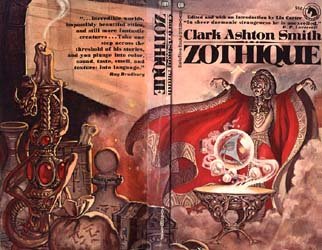
Together we saw it all. I remember as Lin and I climbed onto the back of a reptilian shrowk to fly above the mountains of the Ifdawn Marest with Maskull and the wild and beautiful Oceaxe in David Lindsay's A Voyage to Arcturus. Or when we stood by the cairn with Rhiannon in the world of The Mabinogion, the Welsh Iliad, through the works of Evangeline Walton, a quartet of books beginning with Prince of Annwn. Parched with thirst, Lin and I crossed the burning deserts of the dying continent Zothique and stood frozen in fear with Ralibar Vooz in the caves of Hyperborea with Clark Ashton Smith. We crept down the seven hundred onyx steps and beyond the Gates of Deeper Slumber with H.P. Lovecraft in The Dream Quest of Unknown Kadath. We eyed one another in silent awe as we fled from the descending Powers of Evil, through the Utter Darkness toward the safety of the towering Great Redoubt of William Hope Hodgson's The Night Land, that bizarre and beautifully flawed story of an earth whose sun has died. Swords in hand, we fought the bloody manticore upon Koshtra Pivrarcha with Lord Juss and Lord Brandoch Daha in E. R. Eddison's The Worm Ouroboros, a work written with power and elegance in archaic English.
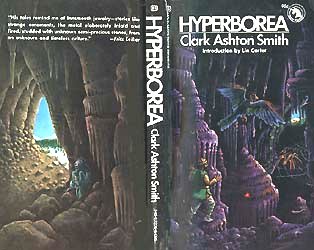
Exhausted, heads spinning, panting, we threw ourselves down to rest. But after a moment Lin and I looked at each other and nodded. He smiled and said, "Let's do it all again." I would have followed him anywhere.
We slipped past the Pool of the Blue Flamingo through the Gate of Khoire in Hannes Bok's Beyond the Golden Stair. We crossed into Faery itself with Alveric to win the heart of the Princess Lirazel in The King of Elfland's Daughter, with Lord Dunsany, possibly the greatest writer of prose in the English language. We crossed those borders again, this time through Dreamland with C. S. Lewis' old mentor, the Scotsman George MacDonald in Phantastes and in Lilith
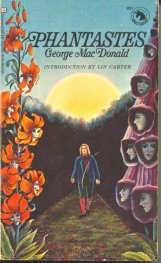
We trod the dusty roads to Utterbol to The Well at the World's End with a genuine Renaissance man in both the arts and literature, William Morris, who might well be called the father of modern fantasy. Lin and I donned masks and gave chase through the streets of turn-of-the- century London in G. K. Chesterton's farcical The Man Who was Thursday and pondered detective's mysteries in Arthur Machen's The Three Impostors. We traveled to the East, in George Merideth's seductive oriental fantasy The Shaving of Shagpat, where I held the hair, while Lin wielded the scissors. We bottled genies in F. Marion Crawford's Khaled, saw the gates of Hell itself in William Beckford's bejeweled Vathek, and sat by the roadside in China to watch the great oriental storyteller, Kai Lung himself, unroll his mat and spin his tales in Ernest Bramah's Kai Lung's Golden Hours.
In works of Lin's own, such as Tolkien: A Look Behind the Lord of the Rings, we sat down for a fireside chat to discuss the making and origins of fantasy. Imaginary Worlds should be a textbook for all fantasy writers everywhere, as it traces the origins and essentials of creating a full-blown fantasy world.
When new writers finally began to surface, Lin brought me the book I consider one of the greatest fantasies of all time, Red Moon and Black Mountain, by Joy Chant. It is nothing less than a masterpiece.
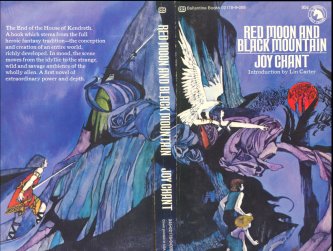
Katherine Kurtz, writer of the popular Dernyi books, also received her start in the Sign of the Unicorn series.
The look of the series was as distinctive as the works
themselves due to the wonderful, abstract wrap-around covers
commissioned by Ian and Betty Ballantine. Three principal
artists did most of the work on the series: Gervasio Gallardo,
whose most striking cover was that of A Fine and Private Place by
Peter Beagle; Robert LoGrippo, whose distinctive mosaic style
decorated The Night Land, The Three Imposters and his best work
of all, The Boats of the Glen Carrig, by William Hope Hodgson, a
beautiful mosaic of men facing unimaginable terrors at sea; and
my favorite artist, Bob Pepper, who was working with dyes at that
time.
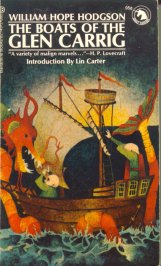
I do not know what economic conditions caused the Adult Fantasy series to end. I know my disappointment was bitter. After Ballantine Books was purchased by Random House, Lin Carter edited a yearly fantasy anthology for DAW books for six years, then I lost track of him. I remember standing in a bookstore browsing through a copy of The Official Price Guide to Science Fiction and Fantasy by Don and Maggie Thompson when I saw Lin's name, with the date of his death below. My face went pale with shock and grief. The friend I never knew was dead, passed away almost two years before. I stood in that strange, sudden loss one can only feel for someone who's words touched them only through the printed page. I had never expressed my appreciation for his work. I had not even known the day he died.
From this web site I discovered he died alone. I regret that. If I could somehow go back in time, I would hurry to the hospital, to tell my old friend and mentor goodbye.
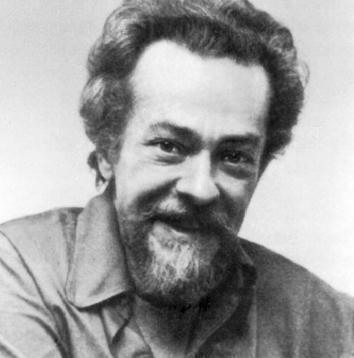
Ken speaking: James Stoddard is a rising fantasy author. He put a very neat tribute
to Lin Carter in his latest book, THE FALSE HOUSE --see if you can find it. I asked
him to say something about himself, and here is a brief biography.
--Ken, 6/23/2000]
Besides being a writer, I love to read mythology and fantasy, and anything else I can find the time for. I also love playing the guitar and writing songs, and am a full-time teacher in Sound Recording and Engineering. My first short story, The Perfect Day, appeared in Amazing Stories magazine around 1985, under the pseudonym of James Turpin. Shortly thereafter, I stopped writing for about ten years to pursue a career in music.
I have two novels out at this time. The first, The High House, won the Compton Crook award for best SF novel by a new novelist, and was nominated for several other awards. Apart from winning the Crook award, I am most proud of The High House being one of the top five finalists for the Mythopoeic Award, an award given to works that best reflect the writing spirit of the Inklings: C.S. Lewis, Charles Williams, and J.R.R. Tolkien.
My second book, The False House, is a sequel.
--James Stoddard, June 19, 2000
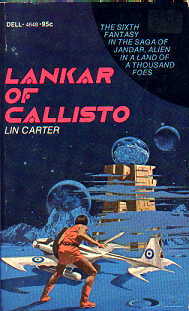
Back in the eighties, when I was a geeky junior high and high school student who spent most of his time reading, most of the reading I did was comics like Ka-zar, Warlord, Savage Sword of Conan, and, above all, Lin Carter novels. In fact, about 90% of what I read besides the aforementioned comics was Lin Carter.
I'd been noticing Lin's paperback covers, especially those to the Callisto books in the science fiction book sections as a young child back in the seventies. And I knew Lin Carter had done a feature article on these books for an issue of Savage Tales, which I had back when I was in first grade (my dad bought these comics for me, even back then, and would read them to me; my mom absolutely detested the things). I first started reading Lin Carter when I deemed myself old enough, in the seventh grade. My first was Hurok of the Stone Age, which I received as a St. Patrick's Day gift upon request. I bought and read the rest of the Zanthodon series as it came out after that, and began searching out all the books in the Callisto series I could find, at used paperback book stores, after which I started on all of Lin's other books.
Even back then, I realized that Lin was not what was considered a great author, and since then, I've graduated to other books, both fantasy-oriented and otherwise, that have much stronger characterization, and more substantial plots than anything by Lin Carter. But in response to some of the more virulent criticism I've read of Lin and his work, especially by Robert E. Howard circles, I will say that Lin did know how to write mesmerizing escapist adventure yarns, which was one thing I felt I needed in the troubling teenage years when I read most of them. And I will defend Lin's quality as a writer in at least one aspect: his power to describe the unreal. Lin Carter was better than any other writer I know (with the possible exception of Robert E. Howard) to paint visual images with words. Lin could imbue his fantastic realities with such vivid detail that he always held me awed, and kept me panting for more.
Also, even though a great deal of what Lin wrote intentionally paralleled Burroughs, the worlds Lin created were still unique unto him; Barsoom might have its gigantic toothy thoats and emerald-skinned giants, but Thanator had its Yathoon arthropods mounted on fierce four-legged avians. Lin Carter had a tremendous outpouring of imagination in the creation of the monsters, civilizations and races that inhabited his various worlds ( only the Callistan Chess Game seemed a little too derivative-maybe he should have tried a game of living Scrabble). And then there was the Green Star series in which Carter really seemed to come into his own. Though clearly Burroughs inspired, Burroughs never invented anything quite like the world of skyscraper-sized trees infested by sentient races and scarlet dragons. Lin's Callisto series reached a real high point when Carter put himself into the story in Lankar of Callisto. You might think this would have been a disastrous move, but as Robert M. Price comments, it worked-and surprisingly well. I still remember reading the part when Jon Dark informs Carter about the Mind Wizards plans to invade Earth, and the ease in which this could be accomplished. That part actually gave me a scare, even though I really knew Lin's statements about the Callisto stories being actual accounts were purely imaginary, and the books themselves had already gone out of print, long after an "invasion" by alien telepaths could have taken place.
Carter's Terra Magica series was less good,[sez you, Tony--some of us consider the Terra Magica tales to be his most imaginative work, In those he harked back to the fantastic literature of the Middle Ages.--Ken] but I still read them, largely because of Carter's great descriptive power. This series did have perhaps an overdosage of whimsy, but it didn't bother me greatly, since I knew this series was supposed to be a more a parody of fantasy novels than the real thing. As others have noted though, Lin was much less successful when he tried to infuse this whimsy into serious novels, most notably the World's End series. These books had good moments when Carter's imaginative power seemed at its peak but they soon lost their flavor because of their overt silliness. If Lin was trying to imitate the Oz books, then one wonders why he didn't bother writing a straight Oz pastiche, like he did with Burroughs pastiches. Some great tastes don't taste great together, as combining Oz with sword-and-sorcery adventure yarns simply didn't work.
Lin Carter's proposed fantasy epic Khymyriam, or what he wrote of it, really does, as R. M. Price suggests, contain some of his most vivid prose, and it's truly a shame Lin never got around to finishing. Maybe this was because Carter was more of the "dreamer" type and lacked the patience to embark on seemingly endless sagas of this scope. Believe me, I can relate to that on a personal level. But still, if it had only seen completion, Carter could have given modern Tolkien imitators like Terry Brooks and David Eddings a run for their money. I sometimes wonder if Lin Carter's vivid desciptive style couldn't be combined through some alchemy with the intricate structure and strong characterizations of authors like Margaret Weiss and Tracy Hickman. The result would be truly phenomenal!
As far as Carter's Conan works are concerned, I have to agree that Carter shouldn't have touched them in the first place. Like all non-Howard works that try to imitate Howard, they fall short. What's mostly missing from Carter's Conan stories is the sense of darkness that is present in Howard's originals. These, like many Robert E. Howard tales, border on being horror stories. But that's really no reason to disparage Carter. I've read Carter's Conan tales in later years, and found them to be actually among his best works. But I've read them as Carter stories, not Conan pastiches.
I realize, of course, that Lin Carter will never take his place in the hallowed halls of literature like certain other modern authors (such as Stephen King, for one) likely will one day. But even if Carter's stories lack enduring quality as literary works, they more than make up for it in sheer escapist adventure. I read them back when I was still struggling through the teen years, and they were just what I needed. Thanks, Lin Carter!
END
Unsolicited testimonials to Lin's influence continue to arrive occasionally. Here's a brief one from Connie
Bracewell, another fan influenced at an early age. Thanks for sharing this with us, Connie!
--Ken
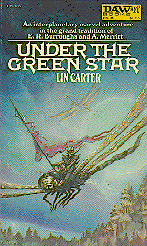
I was about ten when I read the first and third books in the Green Star
series by Lin Carter. After losing the books in a move fifteen or so years
ago, I searched unsucessfully to locate more copies. I recently found a
complete set, and I'm ecstatic! This man's work is responsible for sending me
on a lifelong journey of discovery in the world of fantasy and science
fiction. And I must say, there are virtually no writers today who are
remotely as talented as this incredible man was. What a gift he had with his
words......a man long before his time, and hugely underappreciated. Thank
you, Mr. Carter......you changed my life and opened my mind to wonders I'd
never imagined.
. ~Connie Bracewell, North Carolina~
I was just surfing the web for info on Lin Carter, and I was pleasantly surprised to find your site! I am very familiar with your work as designer of T & T and, of course, the first FRP I ever bought, Monsters! Monsters!
I have been out of the gaming and SF world for about 10 years now, but just the other day while packing, I came upon my Carter books and set them aside for re-reading. Lin Carter was one of the great ones. In my teenage pantheon, he was right up there along with Lieber and Howard. My very first Sword and Sorcery novel was his 'The Wizard Of Zao', which inspired me to start in on Xanth, Conan, Fafhrd and the rest. He had such a great sense of fun that some of the more serious writers lacked. His stories were pure adventure in the most fabulous settings in fantasy. In the years before his death, I read his more recent work with great interest. Mandricardo, Dragonrouge and Callipygia were masterpieces and prompted me to seek out many of the works he referenced. Found Wanting and Down To A Sunless Sea were startling departures from his established style, but utterly fascinating. I was waiting for more from him when I heard he died. If Lin had lived, I am sure his new direction in storytelling would have taken him far and finally awarded him the recognition he deserved.
As a teenaged Carter fan, I was sure that Lin was probably a very happy man. I thought anyone who wrote such magical stories must have a wonderful life. As I learned more about him on your website, I realized that in fact the opposite was true. Lin must have created these worlds of fantasy in part to escape what sounds like a very tragic life. The story of his final days in New York, written by his friend and neighbor, is very sad. The details offered by Jessica Amanda Salmonsson seem to verify this. If only Lin could have had back only a portion of the happiness he gave to all of us fans with his books.
In closing, Ken, I just want to thank you for doing so much to keep the memory of a great, but sadly underrated writer and editor alive. Keep up the good work!
Yours truly,
Mark Taverna
Here's a photo of Lin courtesy of M. Dell (Numa). My thanks, and may I encourage you to share your mementos of Lin Carter with his other fans on these pages.
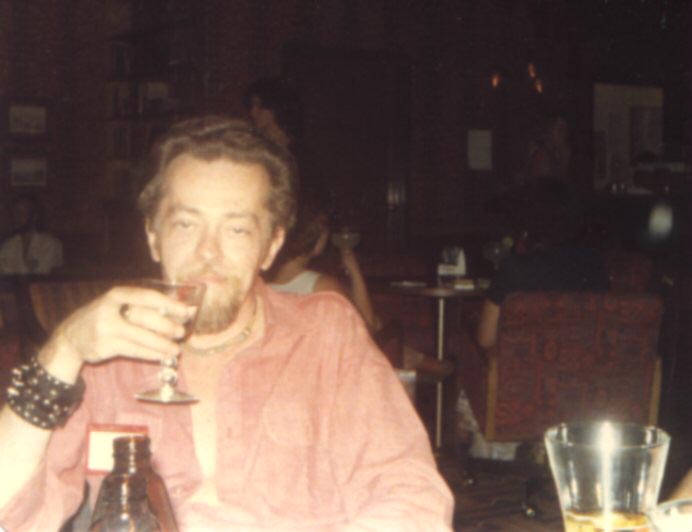
David Truesdale (Editor of the SFWA Bulletin) went to (IGUANACON) the World Science Fiction Convention in Phoenix, Arizona in 1978. He walked into the bar and found Vern Coriell (Founder of the Burroughs Bibliophiles) and Lin Carter sitting together, drinking. He walked up. They invited him to sit down with them. He snapped some pictures, hence the pic, and they all got drunk together. He spent hours drinking with them and talking. He had a good time.
This picture was taken at the hotel bar during IguanaCon in July, 1978, a time
when Lin Carter was at his peak of popularity and success. That was also the time when I actually saw the man, although
I was not in the bar with him on that occasion.
--Ken